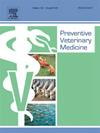Striped catfish (Pangasianodon hypophthalmus) farmers' perspectives on challenges and health management practices in the Mekong Delta, Vietnam: A qualitative study
IF 2.2
2区 农林科学
Q1 VETERINARY SCIENCES
引用次数: 0
Abstract
Striped catfish (Pangasianodon hypophthalmus) farming in the Mekong Delta of Vietnam holds global significance with over a million tonnes produced annually at substantial export value. However, geographic concentration and farming intensity has led to substantial disease-related losses, with underreported concerns and disease control from farmers. This study employs a qualitative methodology to gain insightful perspectives from Vietnamese striped catfish farmers on industry challenges and health management practices. Thematic saturation was sought through qualitative interviews with 44 participants (19 nursery, 21 grow-out, and 4 vertically integrated farms), operating at private- or company-scales across six major production provinces (Dong Thap, An Giang, Can Tho, Vinh Long, Ben Tre, and Long An). Data were thematically analysed using the Framework method, focusing on the intricate interplay between host, environmental factors, and pathogen that contributes to rising disease prevalence and impacts profitability. Farmers articulated distress over escalating disease severity and low survival rates, exacerbated by declining water quality and major technical barriers such as seedstock and broodstock quality. Historically reported diseases, including Bacillary Necrosis in Pangasius (BNP) and Motile Aeromonas Septicaemia (MAS), remained prevalent. However, recent escalation of jaundice and swollen swim-bladder disease in grow-outs, as well as tail-rot disease (Flavobacterium columnare infection) in nurseries, have caused significant economic losses. Larger company-scale farms employed more standardised health management plans and educated staff compared to smaller, experience-based private farms. Antibiotics were perceived as less effective with infrequent antibiotic sensitivity testing, particularly among private farmers, due to inaccuracy. A trend towards reduced usage of antimicrobials and increased preference for dietary solutions was observed, with many farmers describing efforts to avoid antimicrobials, especially near harvest. Common preventive measures include regular environmental treatments and supplementary diets. However, the sector lacks advanced preventative measures, such as vaccination and early detection methods, highlighting the need for improved access to veterinary support to sustain striped catfish farming in Vietnam.
越南湄公河三角洲条纹鲶鱼(Pangasianodon hypophthalmus)养殖者对挑战和健康管理实践的看法:一项定性研究
越南湄公河三角洲的条纹鲶鱼(Pangasianodon hypophthalmus)养殖具有全球意义,每年产量超过100万吨,出口价值可观。然而,地理集中和耕作强度导致了大量与疾病有关的损失,农民的关切和疾病控制报告不足。本研究采用定性方法,从越南条纹鲶鱼养殖户获得有关行业挑战和健康管理实践的深刻见解。通过对44个参与者(19个苗圃,21个生长农场和4个垂直整合农场)进行定性访谈,寻求主题饱和,这些参与者在六个主要生产省份(东塔,安江,芹苴,永隆,本特里和龙安)以私人或公司规模经营。使用框架方法对数据进行了主题分析,重点关注宿主、环境因素和病原体之间复杂的相互作用,这些相互作用导致疾病患病率上升并影响盈利能力。农民表达了对疾病严重程度不断升级和存活率低的担忧,而水质下降和种子和亲鱼质量等重大技术障碍又加剧了这种担忧。历史上报道的疾病,包括巴沙鱼细菌性坏死(BNP)和运动性气单胞菌败血症(MAS),仍然普遍存在。然而,最近在苗圃中黄疸和肿胀的鱼鳔疾病的升级,以及尾腐病(柱状黄杆菌感染)造成了重大的经济损失。与规模较小、以经验为基础的私人农场相比,规模较大的公司农场采用了更标准化的健康管理计划和受过教育的员工。由于不准确,人们认为抗生素在不频繁的抗生素敏感性测试中效果较差,特别是在私营农民中。观察到减少使用抗菌剂和增加对饮食解决方案的偏好的趋势,许多农民描述了避免使用抗菌剂的努力,特别是在收获期间。常见的预防措施包括定期环境处理和补充饮食。然而,该部门缺乏先进的预防措施,例如疫苗接种和早期发现方法,这突出表明需要改善获得兽医支持的机会,以维持越南的条纹鲶鱼养殖。
本文章由计算机程序翻译,如有差异,请以英文原文为准。
求助全文
约1分钟内获得全文
求助全文
来源期刊

Preventive veterinary medicine
农林科学-兽医学
CiteScore
5.60
自引率
7.70%
发文量
184
审稿时长
3 months
期刊介绍:
Preventive Veterinary Medicine is one of the leading international resources for scientific reports on animal health programs and preventive veterinary medicine. The journal follows the guidelines for standardizing and strengthening the reporting of biomedical research which are available from the CONSORT, MOOSE, PRISMA, REFLECT, STARD, and STROBE statements. The journal focuses on:
Epidemiology of health events relevant to domestic and wild animals;
Economic impacts of epidemic and endemic animal and zoonotic diseases;
Latest methods and approaches in veterinary epidemiology;
Disease and infection control or eradication measures;
The "One Health" concept and the relationships between veterinary medicine, human health, animal-production systems, and the environment;
Development of new techniques in surveillance systems and diagnosis;
Evaluation and control of diseases in animal populations.
 求助内容:
求助内容: 应助结果提醒方式:
应助结果提醒方式:


